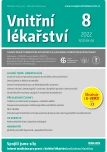Pulmonary storage
Authors:
Martina Šterclová
Authors‘ workplace:
Pneumologická klinika 1. LF UK a Fakultní Thomayerovy nemocnice, Praha
; Pneumologická klinika 2. LF UK a FN Motol, Praha
Published in:
Vnitř Lék 2022; 68(8): 525-531
Category:
Review Articles
doi:
https://doi.org/10.36290/vnl.2022.111
Overview
Interstitial lung diseases (ILDs) are not just a matter of scarring or inflammation in the lung tissue. The lungs can also serve as a repository for products that can be produced in excessive amounts in the human body as a result of disease.
Geneticaly based dysfunctions of lysosomal enzymes, which leads to an unefficient degradation and transport of various macromolecules from lysosomes, are considered to be storage diseases sensu stricto. ILDs were described in patients with Gaucher disease, Niemann-Pick disease and Fabry disease. In a broader context, however, the accumulation of various substances in the lung tissue is also encountered in cases of pediatric pulmonary interstitial glycogenosis (PIG), alveolar lipoproteinosis or pulmonary amyloidosis.
The cause of PIG is not clear. The disease was first described in 2002 and a lung tissue sample is required to establish this diagnosis. Even though PIG usually goes well in childhood and the patients‘ difficulties spontaneously subside over time, the long-term prognosis of the patients is unknown.
Alveolar lipoproteinoses can be acquired (e.g. after massive exposure to silica dust), autoimmune, but also genetically determined. Unlike lysosomal storage diseases, in the case of pulmonary alveolar lipoproteinosis, accumulation of abnormal macromolecules occurs only in the lungs of affected individuals. Similarly, amyloidosis is not a single disease, but a group of diseases with different etiopathogenesis, as a result of which amyloid – a group of different proteins with a distinctvive conformation, which can be deposited in various organs, including the lungs – is formed. The diagnosis of pulmonary alveolar lipoproteinosis is based on the typical appearance and biochemical composition of the fluid obtained by bronchoalveolar lavage, the diagnosis of amyloidosis is histological.
Keywords:
Amyloidosis – lysosomal storage diseases – pulmonary alveolar proteinosis – pulmonary interstitial glycogenosis
Sources
1. Ramaswami U, Mengel E, Berrah et al. Throwing a spotlight on under‑recognized manifestations of Gaucher disease: Pulmonary involvement, lymphadenopathy and Gaucheroma. Mol Genet Metab. 2021;133(4):335-344.
2. Myerowitz R, Puertollano R, Raben N. Impaired autophagy: The collateral damage of lysosomal storage disorders. EBioMedicine. 2021;63:103166.
3. Faverio P, Stainer A, De Giacomi F, Gasperini S, Motta S, Canonico F, Pieruzzi F, Monzani A, Pesci A, Biondi A. Molecular Pathways and Respiratory Involvement in Lysosomal Storage Diseases. Int J Mol Sci. 2019;20(2):327.
4. Benson MD, Buxbaum JN, Eisenberg DS, Merlini G, Saraiva MJM, Sekijima Y, Sipe JD, Westermark P. Amyloid nomenclature 2020: update and recommendations by the International Society of Amyloidosis (ISA) nomenclature committee. Amyloid. 2020;27(4):217-222.
5. Iftikhar H, Nair GB, Kumar A. Update on Diagnosis and Treatment of Adult Pulmonary Alveolar Proteinosis. Ther Clin Risk Manag. 2021;17:701-710.
6. Liptzin DR, Baker CD, Darst JR, Weinman JP, Dishop MK, Galambos C, Brinton JT, Deterding RR. Pulmonary interstitial glycogenosis: Diagnostic evaluation and clinical course. Pediatr Pulmonol. 2018;53(12):1651-1658.
7. Borie R, Crestani B, Guyard A, Lidove O. Interstitial lung disease in lysosomal storage disorders. Eur Respir Rev. 2021;30(160):200363.
8. Baker KR, Rice L. The amyloidoses: clinical features, diagnosis and treatment. Methodist Debakey Cardiovasc J. 2012;8(3):3-7.
9. Salvaterra E, Campo I. Pulmonary alveolar proteinosis: from classification to therapy. Breathe (Sheff). 2020;16(2):200018.
10. Seidl E, Carlens J, Reu S, et al. Pulmonary interstitial glycogenosis - A systematic analysis of new cases. Respir Med. 2018;140:11-20.
11. Pastores GM, Hughes DA. Gaucher Disease. 2000 Jul 27 [updated 2018 Jun 21]. In: Adam MP, Everman DB, Mirzaa GM, Pagon RA, Wallace SE, Bean LJH, Gripp KW, Amemiya A, editors. GeneReviews® [Internet]. Seattle (WA): University of Washington, Seattle; 1993–2022.
12. Thurberg BL, Diaz GA, Lachmann RH, Schiano T, Wasserstein MP, Ji AJ, Zaher A, Peterschmitt MJ. Long‑term efficacy of olipudase alfa in adults with acid sphingomyelinase deficiency (ASMD): Further clearance of hepatic sphingomyelin is associated with additional improvements in pro- and anti‑atherogenic lipid profiles after 42 months of treatment. Mol Genet Metab. 2020;131(1-2):245-252.
13. Beck M, Ramaswami U, Hernberg‑Ståhl E, Hughes DA, Kampmann C, Mehta AB, Nicholls K, Niu DM, Pintos‑Morell G, Reisin R, West ML, Schenk J, Anagnostopoulou C, Botha J, Giugliani R. Twenty years of the Fabry Outcome Survey (FOS): insights, achievements, and lessons learned from a global patient registry. Orphanet J Rare, DiS. 2022;17(1):238.
14. Moy LN, Mirza M, Moskal B, Asado N, Shah B, Bitran J. Pulmonary AL amyloidosis: A review and update on treatment options. Ann Med Surg (Lond). 2022;80:104060.
15. Raimondi S, Porcari R, Mangione PP et al. A specific nanobody prevents amyloidogenesis of D76N β2-microglobulin in vitro and modifies its tissue distribution in vivo. Sci Rep. 2017;7:46711.
16. Nevone A, Merlini G, Nuvolone M. Treating Protein Misfolding Diseases: Therapeutic Successes Against Systemic Amyloidoses. Front Pharmacol. 2020;11:1024.
17. Ataya A, Knight V, Carey BC, Lee E, Tarling EJ, Wang T. The Role of GM‑CSF Autoantibodies in Infection and Autoimmune Pulmonary Alveolar Proteinosis: A Concise Review. Front Immunol. 2021;12:752856.
Labels
Diabetology Endocrinology Internal medicineArticle was published in
Internal Medicine

2022 Issue 8
Most read in this issue
- Selected severe „haematological“ syndromes in adult intensive care patients
- Today's view of hereditary thrombophilia
- Allergen immunotherapy in treating allergic eosinophilic asthma
- Antithrombotic therapy and digestive endoscopy
